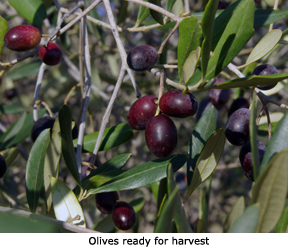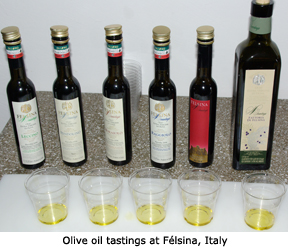Olive Oil: Production and Tasting
by Kathy Sullivan
From Wine Trail Traveler Newsletter, November 2007
Driving through the Chianti countryside in Italy can make one almost feel Italian. Perhaps much in the same way that on St. Patrick’s Day, everyone wants to be Irish.
The heritage inherent in the stone buildings scattered throughout the area, gives one a sense of history and perseverance. Acres and acres of vineyards are prevalent up and down hillsides. Olive groves are numerous and olive trees line driveways and roads as well as dotting vineyards.
Olive trees have some of the same horticultural attributes and needs as grapevines and therefore Tuscany is an ideal region for olive groves. Olive trees like grapevines need to be pruned heavily late winter/early spring. Olives also have a terroir and take on the essence of the area in which they grow.
Aware of wine tastings, walking into a tasting room for an olive oil tasting was a unique experience. Does oil really have a significant flavor? Is there really a nutritious oil? A visit to Félsina answered those questions. Yes, there is a significant flavor and if properly produced olive oil is nutritious.
 Workers harvest olives when they show about 40 percent verasion. In late October and November 2007, harvesting was taking place in Tuscany. At the time of harvest, olives are green, black and various shades in between. The harvesters use a small hand rake or a motorized rake that flaps back and forth rapidly bringing down olives and leaves. Workers lay heavy nets beneath the tree to catch the falling olives and leaves. Olives are placed in bins and brought to the facility to produce oil. The leaves are removed, olives crushed and pits removed. The water from the olives is removed and only the olive oil remains.
Workers harvest olives when they show about 40 percent verasion. In late October and November 2007, harvesting was taking place in Tuscany. At the time of harvest, olives are green, black and various shades in between. The harvesters use a small hand rake or a motorized rake that flaps back and forth rapidly bringing down olives and leaves. Workers lay heavy nets beneath the tree to catch the falling olives and leaves. Olives are placed in bins and brought to the facility to produce oil. The leaves are removed, olives crushed and pits removed. The water from the olives is removed and only the olive oil remains.
Félsina has a separate olive oil making facility. On the day of our visit, they were pressing a single varietal olive oil following the Veronelli method. Several machines are used for retrieving the olive oil from the olives. The process consisted of four separate operations. The first machine separated the olives from the leaves and stems. The second machine pitted the olives. In the third machine the olives are kneaded into a paste and protected from oxygen. The last machine extracted the oil. After the oil was separated from the olives, the oil was pumped into large stainless steel tanks.
Since olive oil does not need to be fermented like wine, it can be bottled immediately. Nearby was a separate bottling machine. Bottling at this winery does not take place until there is an order. One employee was bottling the olive oil one bottle at a time. Another machine was blending different olive oils together and bottling the oil in a larger container.
 If you have the opportunity when in Italy, take time to participate in an olive oil tasting. A small plastic cup was set before each bottle of oil. Each cup held a small amount of oil. Our host demonstrated how to taste the olive oil. For the best flavor, she held the cup in her hand and covered the top with her other hand. Twisting the cup back and forth slightly warmed the oil and released its aroma. Just as in wine tasting, aroma is important.While one person thought there was a green apple aroma, another thought there was a grassy aroma. As we sipped the first oil, there was little flavor however as the oil reached the back of the tongue a hint of spices came through. As the sipping progressed, the last varietal oil had the most significant taste of spices.
If you have the opportunity when in Italy, take time to participate in an olive oil tasting. A small plastic cup was set before each bottle of oil. Each cup held a small amount of oil. Our host demonstrated how to taste the olive oil. For the best flavor, she held the cup in her hand and covered the top with her other hand. Twisting the cup back and forth slightly warmed the oil and released its aroma. Just as in wine tasting, aroma is important.While one person thought there was a green apple aroma, another thought there was a grassy aroma. As we sipped the first oil, there was little flavor however as the oil reached the back of the tongue a hint of spices came through. As the sipping progressed, the last varietal oil had the most significant taste of spices.
Single varietal olive oil production is as fascinating as the production of wine.
